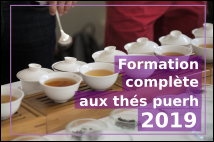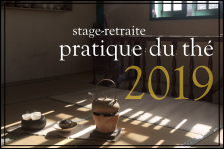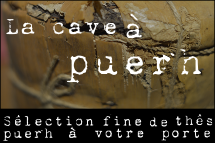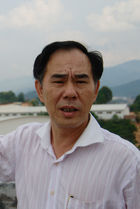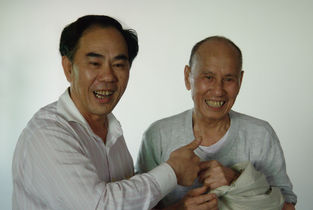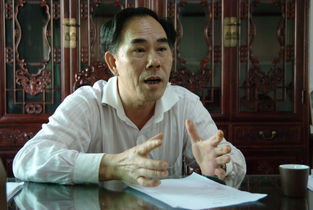 This page is not a real translation but just an automatic translation generated by computer of the original article, written in French language! Its not good... but better than nothing!
This page is not a real translation but just an automatic translation generated by computer of the original article, written in French language! Its not good... but better than nothing!Want to help us do diffuse puerh tea culture in english, by providing a better (or corrected) translation?
Please contact us!

Arrived on the market puerh (Pu Er tea) it there's only a few years, Chen Sheng Hao is an ambitious producer whose teas have already forged a solid reputation among fans. Especially if you have heard of this producer almost exclusively he signed the Lao Banzhang terroir, terroir today the most sought after and most expensive in Yunnan, the history of this producer does arette there.
To learn more I have the chance to get them in 2010 a long relationship with Chen Sheng He, the man behind Chen Sheng Hao. Before proposing a visit to the owner and a full article on the producer and his production I am pleased to draw today through this interview was one of the fast extraordinary personality from the world of tea. Both businessman and outstanding magician tea can not only buy a mountain but also to deal with fine leaves to produce tea that tends towards perfection, Chen Sheng He, his 59 years is a man who knows where it goes, and whose charm and charisma inspired if not admiration, respect.
The history of Chen Sheng He begins to Shantou (汕头) in 1974. Completing his studies, he began to look for work. China lived a difficult period and if we had the misfortune to be a little too demanding it was not so easy to find their way in the world of work. Thus Chen Sheng He began his career by selling tea quietly he bought directly from producers. China was at that time in full communist era, all the tea in theory passed by state factories and it was not legal to resell kind of tea purchased directly from the producer. If it had a certain danger that reported in part against a lot of money, tea being at that time nearly 30% cheaper for producers in state factories.
In 1983, China's economic opening which began in 1969, a new step and private trade tea becomes easier. Chen Sheng He took the opportunity to legalize their activity, then moved to Shen Zhen in 1989 where he remained for nearly 20 years. For Hong Kong Chinese, large commercial port, the choice is very strategic and successful pioneer since its inception. Chen Sheng possess and in 1989 nearly 60% of the tea market in Shen Zhen. Shen Zhen 80 years, by its position, moves a lot and quickly became the meeting place for all types of Chinese teas, green, longjing, bi luo chun, mao feng, etc., and of course the oolong, considered tea the most technically difficult. If Chen Sheng then sells mainly oolong it opens to all types of tea, green, white, black and puerh (Pu Er tea) tiny amount. In the late 80s the world of puerh (Pu Er tea) is indeed more located in Taiwan, Malaysia and Canton and the market is mostly composed of fermented puerh.
Chen Sheng in these years a very influential position in the market Sheng Zheng. Nourished by a great ambition and a thirst for knowledge, he uses this position to improve his knowledge of various Chinese teas and open to the outside. It is thus one of the first to open his factory to the public, will welcome people from all over China to taste his tea, and met many masters of teas.
It is at this time that Chen Sheng He decides that the tea will be the path of his life. If this choice seems pretty obvious given the strong position it enjoys in the tea trade and prosperity in which he finds himself, Chen Sheng He likes to say that what motivated him then and foremost, it was potential that tea has to make people happy, and a way to erase the marks of age: When an older person drinks a cup of tea, she feels the same pleasure qu'éprouverait a young man or young woman, and it gives the tea is something noble, a power to diffuse happiness beyond the ages.
It was then that he began to visit and thoroughly for more than 10 years China tea, the regions from which the great Chinese teas, and one after another the various mountain tea. In 2006, at the end of this long journey, he finally landed in Yunnan and made the discovery that would change the course of his life: tea puerh. After the first month to walk in the mountains of Lincang he returns to Zheng Sheng before returning for the second month in Yunnan, this time in the region of Menghai. This second trip was experienced by Chen Sheng He as a great shock and cause a particular attraction for puerh. Menghai it up north and visited the different terroirs of Simao finally back in Xishuangbanna where grows the best tea for him.
A Chinese proverb says that the height of a tree is equal to the depth of its roots. He Sheng Chen for this is precisely that is the unique charm puerh. Their deep roots, old tea trees in Yunnan draw the essence of mountain depth, away from pollution and in the spring cup the flavor of the mountain . The eyes of Chen Sheng He is what makes the difference with other types puerh (Pu Er tea) tea, something that no technology can match, and this is the flavor of the mountain puerh (Pu Er tea) that draws its potential to improve over the years.




- 1. Site on which Chen Sheng He built his factory in Menghai
- 2. Driveway future garden bordering the factory Chen Sheng
- 3. Chen Sheng He in the mixing room plant Sheng Chen
- 4. Factory Chen Sheng Hao
Following this trip, experienced as a kind of revelation, Chen Shen He decided to settle in Menghai, despite strong competition present in the region and advice from different specialists tea. He bought land in 2007 to build the "project of his life." Then 56 years old it is for him a kind of completion, the culmination of over 20 years of travel in the tea. The reasons for this choice Chen Sheng He says he has "everything" to Zheng Sheng, a company that runs a lot of property in the estate, prosperity, an enviable position, but nowhere to develop its own project the work of his life. After a long search the location of this business is with unshakeable confidence that arises Menghai and a landscape bathed by the market crisis and where puerh (Pu Er tea) factories in the region are closing one after the other, it built his factory puerh. More than just plant is an ambitious project which is now in full development. Different varieties of tea grown gradually in what will soon be a large garden in the heart where it will be possible to restore sipping fine teas. Then aged 56, he poses with great conviction the goal of this project for 10 years: that is interested in the next 5 years and the brand is known and recognized by 10 years. Today, only four years after the foundation stone for the factory was laid we can say that the bet has been more than fulfilled.
a relationship with Chen Sheng He
produce the best tea for connoisseurs, and other tea available that everyone can afford to buy.
All teas should be equal to satisfy the connoisseur, after some must also be affordable and reach a wider audience.
No. The project in which I am engaged for 4 years already colossal, I am 59 years old now and it's a little too late for me to this ... the only thing I can do is to choose, select and assemble the best leaves it.
I got to Banzhang in 2007 and I was struck by the unique taste of this tea terroir, the exceptional influence of land and forest that covers it. The aroma of tea Banzhang something a trickle of water flowing away, something discreet but tough. It's like a chicken soup, it is not the same thing long simmer the chicken or to add MSG (a flavor very common and used daily in China). This is like someone with a great culture and whose richness and subtlety of vocabulary would flow slowly over the sentences. Just as we can talk for days without getting tired with this kind of people, you can drink all day tea Banzhang without ever getting tired.
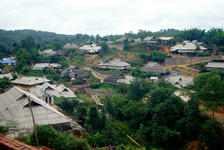
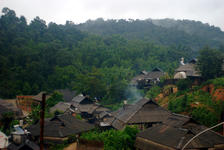
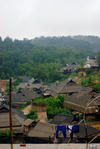

- 1. Village Banzhang Lao, Shan Bulang
- 2. Village of Banzhang Lao, Shan Bulang
- 4. Brick Chen Sheng Lao Banzhang 2010, freshly squeezed.
It was a purely speculative, they are businessmen who have so dramatically raised the price of tea, but what matters most is the quality of the tea, the absence of any surrounding pollution and uniqueness of the terroir of Banzhang. In 2008 the bubble explodes and kilogram mao cha (raw uncompressed) Banzhang fall of around 400 RMB (). This is when I started chatting with the villagers.
Faced with the drastic drop in the price of tea Banzhang between 2007 and 2008 (from 1700 RMB () to 400 RMB () NDR) and to help the farmers, I got great support from the government in this initiative. The production of this soil is not so large (50 tons NDR) and tea Banzhang something exceptional that deserves extraordinary measures. If it had not been bought at that time he would probably have been impossible to find today.
year 2008 was disastrous for the world of puerh. While that of the kg mao cha Banzhang fell to around 400 RMB (), it tumbled around in the 30 RMB (). For the government to sign the purchase contract of tea this region for a long time was a good thing on the one hand to help small farmers in this village, and secondly to prevent dislocation of the village facing a multitude of businesses attracted by the high price of this tea. Government for me it provided strategic support to help convince farmers to sign this contract. He has played and still plays a mediating role in this case.
The major problems were accessibility of the village, the problem of falsification tea and competition from other buyers. The village is particularly Lao Banzhang down and end dirt road to get there originally was virtually impassable, you could put nearly two days to reach the village. That is why I rebuilt the road and funded this work.
The problem of adulteration of tea from the farmers themselves, who imported the leaves of neighboring lands to mix the real mao cha Banzahng was a big shock to me, and also the most difficult problem to solve. Along with this it is difficult for many in the tea market to accept that someone might have an exclusive terroir looking like the Banzhang and I met countless problems of competition or selling under the cloak and "contract out" from the producers of the village.
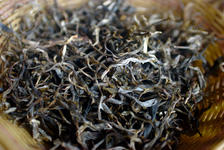
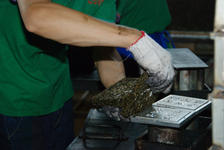
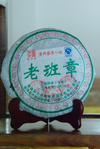
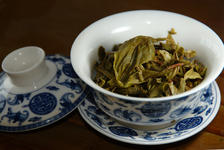
- 1. Mao Cha from a small producer Banzhang
- 2. Production of square Banzhang Lao Sheng Chen 2010
- 3. Famous cake Banzhang Lao Chen Sheng 2008
- 4. Infused leaves the square Banzhang Lao Sheng Chen 2010
This comes first experience and my goal is foremost to produce tea of excellence and not much money. About 100 kg of Maocha I buy only 90 and eventually will be used in the cups!
To illustrate this I suggest you try a cake now a collector, the first production Banzhang Lao Chen Sheng, pressed by Chen Sheng Hao in 2008, and the 2009 vintage of this Tea exception.
 Chargement du thé...
Chargement du thé... Chargement du thé...
Chargement du thé...Yes that is correct.
It there's two reasons. Firstly, the farmers do not have enough money. Therefore if I want to improve product quality, cleanliness and quality of work sheets and uniformity of result, it is for me to do. Before, many farmers eg dried leaves on the ground, etc.. Then I can now send up technicians with a better technique to further increase the quality and purity of the product. The government has also largely pushed me in this direction, producing a clean and reputable.
(laughs), no no I have not received any funding from the state.
machines are there to alleviate the conditions météologiques. When it rains we have to work very quickly to prevent sheets deteriorate and therefore to use the machine. If a machine is being used allows a result as good as manual labor.
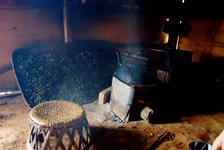
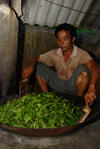
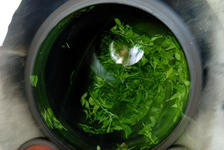
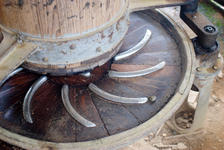
- 1. sheets drying in the smoke, the fire in bad weather in a small Lao Banzhang producer
- 2. Sha qing manual by a small producer Bulang
- 3. machine to sha qing Bulang
- 4. Old typewriter each road in the village of Lao Banzhang
For me machine allows sha qing (first leaf drying) quality that can be done by hand and better temperature control. But what other steps the manual labor is best. This is the first year of the workshop Lao Banzhang I probably égaliserais practices over time ... but for the time and given the results I prefer to do the sha qing mechanically.
Because people who work Banzhang are accustomed to working hand. I send outside specialists to increase technical and supervise the work but all workers in the village. For the moment they have not used the machine but that will change and we will gradually increase the generalization of qing sha mechanized. The problem of sha qing hand is its vagueness, it is often too much or not enough, the technique is crucial at this stage. Other steps as each road or press cakes are always made for them by hand.
I suggest you to try to illustrate this first in the famous 2010 vintage Banzhang Lao Chen Sheng Hao, worked for the first time from the fresh leaf in the studio of producer and compare it to the previous vintage produced from Maocha worked at home by villagers.
 Chargement du thé...
Chargement du thé...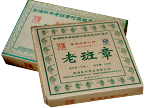
comparatif
Chen Sheng Lao Banzhang 2009 vs. Lao Chen Sheng Banzhang 2010
More than simply reflect the character of these two years, this comparison makes sense when you know that the 2010 edition is the first tea Lao Banzhang to have been worked by Chen Sheng Hao from fresh leaf in workshop, which was opened in the village in 2010, where the two previous vintages have summers products from Maocha worked at home by the different families of the village.
Leaves that mingle on the surface of these teas are very close. There is a slightly darker color on the leaves of 2009 but the difference is minimal.
Once infused teas both produce a liqueur of the same color, but with a liquor more beautiful, bright and clear for the vintage 2010.
The fragrance that emanates leaves seems to say the same thing: If we are very close, and if these teas are undoubtedly from the same region, but the same approach when the selection and assembly, perfume leaves as compared to 2010 appears finer and purer than the previous year. Faced with this perfect purity of the 2010 vintage is detected in the 2009 touches very lightly smoked, which can be attributed to the presence of smoke in the area during the Qing Sha or drying of leaves, and justifying the measures taken by Chen Sheng He to take over the work sheets in a place specifically built for it.
This observation finds that good taste, especially in fragrances that develop in the nasal cavity during the tasting. If taken independently the 2009 vintage has no default, and is definitely a puerh (Pu Er tea) very high level, a careful tasting in conjunction with the 2010 edition makes it appear as more "raw" and less end, where new vintage 2010 broke with finesse and flawless purity. Slightly less bitter, this new vintage is gaining brightness and smooth, but slightly in intensity.
We can not attest to the success of the strategy and investment Chen Sheng He further improve this product already considered remarkably fine by amateurs. The result is a vintage 2010 character unchanged, but the increased purity: extracting nectar Lao Banzhang as no one had ever done so far!
Yes I bought the place in 2007. This is the workshop of a very old renowned producer Wu Yi before the communist era, Fuyuan Chang (福 元 昌). Production has ceased and the brand no longer exists (it was actually bought NDR) but there was the workshop of 200 to 300 square meters.
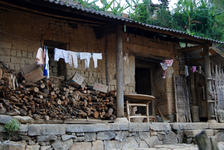
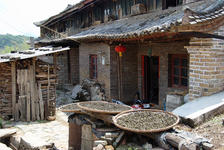
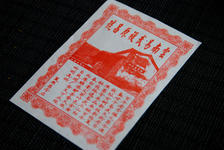
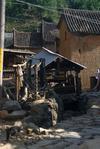
- 1. Old Village of Yi Wu
- 2. Old town of Yi Wu
- 3. Nei Piao Chen Sheng Wu Yi representing the former workshop Fuyuan Chang
- 4. Old town of Yi Wu
Because I was too busy here (Menghai) and Banzhang. Alongside the work Banzhang therefore, construct, start up the plant and out Menghai teas of this quality in just three years has been very addictive. That's why I waited to begin in 2009 to look into YiWu.
 Chargement du thé...
Chargement du thé...Yi Wu is not only one of the six major mountain tea, but has a very old history. Menghai has built a strong reputation in recent years but the history of Yi Wu has its sources in a much more distant past.
Banzhang is very limited and local tea is good Banzhang share this land. Wu Yi is a great mountain home to many terroirs ... but I find the best Wu Yi Tea For now I'm still looking, but it will be great see.
Yes this tea is still under development and it will take a lot of time. The question is very different from Banzhang he is not there to buy all the tea village. There are a lot of very different teas and different tastes in Yi Wu and what matters is to find the right one. I have to make time for this to go myself on site, etc., and it takes time.
Let us taste a cake to illustrate this extremely rare series produced in very limited by Chen Sheng He contest for the best tea Wu Yi in 2010 (won in 2010 by Baopuxuang).
 Chargement du thé...
Chargement du thé...In 2011
Not available at the first publication of this talks in 2010, here are two teas produced by Wu Yi Chen Sheng Hao in 2012, in its later, the Fu Yuan Cheng Bing (usually just called 357g) and cheaper edition, the Fu Yuan Yuan Cha (usually just called 400g).
 Chargement du thé...
Chargement du thé... Chargement du thé...
Chargement du thé...These teas are still as Yi Wu Chen Sheng He developing during their first walked out on in 2009, here is a comparison between the 2009 version and the first version "complete" the Fu Yuan Cha ( also called 400g) Output 3 years later.
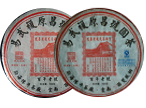
comparatif
Chen Sheng Wu Yi 400g vs 2009. Chen Sheng Wu Yi 400g 2012
Scent escaping leaves immediately recognizes the commonality of these two teas, including this high dimension characteristic fruity and spicy. It obviously has to do the same chemistry and the same look on Tea Yi Wu
We find exactly the same taste: two teas that have committed the same character and are mostly separated by 3 years of natural aging. We find this particularly beautiful fruity and spicy dimension that characterizes this tea, excellent intensity and depth, and a remarkable propensity to invade the palate and nasal cavity.
The year 2012 appears naturally as younger, fresh and sharp, but it also appears to be more intense and dense in the mouth. Tea and 2012 seems totally in line with the 2009 and has the same character created by Chen Sheng He. However, it appears to be substantially deeper, fine and complex than the 2009 tasted it there's 3 years. If it has and most likely the excellent potential for maturation of his elder, it surely promises even better for the future!
The place that I build in Yi Wu is very different from Banzhang. A Yi Wu is not going to be a primary processing unit. Farmers with whom we work will continue to work as they always have and we'll buy mao cha worked that we will press at the factory. Place of Yi Wu is mainly there to analyze and choose mao cha ... there will also be a kind of museum that can be visited.
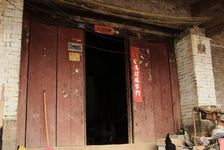

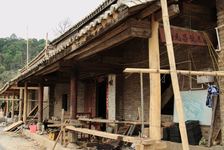
- 1. Former workshop Fuyuan Chang Yi Wu
- 2. Restaurtion-Recontruction Fuyuan Chang Chen Sheng He in 2012
- 3.-Restaurtion Recontruction Fuyuan Chang Chen Sheng He in 2012
It y'avait little technique before, now much more. Other teas Yi Wu are worse now ... but after 10 years it will appear as a new face.
Yes. Technology has progressed, things are cleaner too. The taste will be better in the future too. Today the prices have dropped and bad tea is worthless ... So farmers are forced to improve their technique and produce the finest teas ... everything will get better with time.
Not ... it's too tiring ...
purity is the right path. After it is necessary to resort to mixing and design revenue in this way. To make a good tea should taste is balanced. We must therefore make the mixture within a search for purity.
Three things make a good tea: The flavor of the mountain, a certain thickness and density, and a good smell. The purpose of the recipe is to combine these three dimensions.
That's not enough. The soil but its importance and technical mixture can not reach a balanced tea that combines the three points I mentioned.
Yes. Firstly it there's the selection and sorting, sheet by sheet. Anything that is not good enough or not good enough worked is removed. Then there's the recipe. Although Banzhang is a very limited and local character marked mao cha various gardens around the village have their own personality. Some are very bitter, some sweeter, others smell particularly valuable. Using a mao cha here and there, you will not get the same tea. The purpose of the recipe is precisely to balance that approach perfection. Each step is very subtle, so you press four four patties the same soil, they are all different.
The puerh (Pu Er tea) a very long story, but before China was very closed and difficult path. Today China is open, things are much easier, and make tea. But there's still need some time, at least ten years ...
In China ... finally it does not take long either they drink puerh (Pu Er tea) really. It is only at the beginning.
It there's three things to understand in the puerh. Firstly the puerh (Pu Er tea) is good for your health and makes you lose weight. China is becoming richer and the standard of living of the Chinese is increasing. When we have money we eat more and more parallel asks for his health and have more to invest in this: it becomes a need. At first the puerh (Pu Er tea) was considered a drug and is used in traditional medicine, now it becomes a drink. Before the opening of China was lacking food ... more if we had been drinking puerh (Pu Er tea) ... there is more old in China today (laughs).
We start with the export here to understand that it is more strict in other countries, food standards, use of pesticides and fertilizers, etc. ... so it becomes more strict and demanding, and it is for tea today and tomorrow.
Today puerh (Pu Er tea) is not expensive, but in 10 years it will be understood more value puerh. Prices will rise steadily and you can expect about 20% increase per year over the next 5 years. Today many people speak and hear about puerh, but few people really know and understand this tea.
The puerh (Pu Er tea) existed for over 1000 years, despite ups and downs, because it has always been a useful function. It is natural now to overcome this and to try to increase his knowledge in this tea.
I am doing something in this direction is to radically separate my teas price for old trees and those from tai di (terrace cultivation), to make clearer the true value of puerh. (This was clearly established in 2012 with two cakes Yi Wu Sheng Hao Chen poduite NDR)
A price that is reasonable in my eyes for a mao cha gross Banzhang is 3000 RMB () per Kilogram and believe me it is not expensive. This will be the situation in the next 5 to 10 years.

